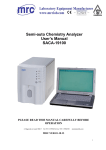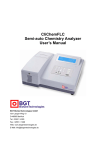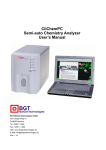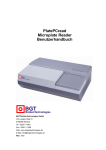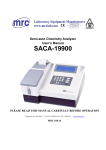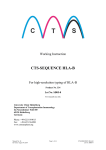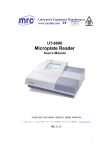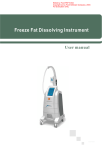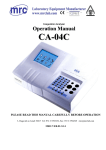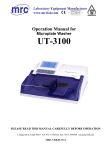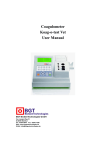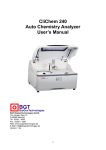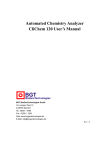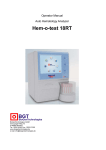Download CliChemPlus Semi-auto Chemistry Analyzer User`s Manual
Transcript
CliChemPlus Semi-auto Chemistry Analyzer User’s Manual BGT BioGenTechnologies GmbH Von-Langen-Weg 10 D-48565 Steinfurt Tel.: 02551 / 4090 Fax.: 02551 / 1298 Web: www.biogentechnologies.de E-Mail: [email protected] Rev: 1.2e CliChemPlus User’s Manual How to use this manual It’s greatly appreciated you become the user of CliChemPlus Semi-auto Chemistry Analyzer. In order to get the best effect, you must be familiar with our instruments and their functions before performing the clinical diagnostic tests. This manual is the operating guidance of CliChemPlus Semi-auto Chemistry Analyzer of BGT BioGenTechnologies Company, which including the contents of instrument installation, daily test, quality control, and daily maintenance, etc. As to the users who uses external printer, please refer to the user’s manual of external printer at the same time. Please reserve all the packing materials for the use of deposit, transportation and maintenance in the future. You may contact with your distributor if there is any problem. As to the instruments of different version or configuration, their functions are slightly different. Note: Indications, advices and suggestions. Italics are used to differ from each other. Warning: Warning indications must be obeyed, so as to ensure the normal operation of instruments and correct and real test results. Bold-face is used to make the difference. 2 CliChemPlus User’s Manual Symbols on the instrument Symbols on the instrument This symbol means that the labeled item is hot while the instrument is in use. Don’t touch the labeled item as you could be scalded. The symbol is labeled on the lamp support of optic system. This means that the labeled item could lead to personal injury and/or damage to the analyzer. The symbol is labeled beside the power outlet and some external interface. The symbols for “SERIAL NUMBER”, The serial number shall be after or below the symbol, adjacent to it. The symbol means the product is in vitro diagnostic medical device. The symbol indicates the manufacturer and its address, after which are shown its name and address. The symbol indicates EU representatives of the manufacturer and their addresses, after which are shown their names and addresses. The symbol indicates biological pollution, marked in the part where the instrument contacts the clinical reagent. The symbol appears in black side and yellow background. Symbols on the sales packaging The symbol means that the environment of instruments must be dampproof in the course of transport, and instrument must be kept in a dry environment. This means that instrument should handle with care in the course of transportation, so as not to damage it. The symbol means the instrument packaged should not be upended at any time The symbol means that the level piled up can't exceed 8 layers, as not to damage instrument. The symbol indicates temperature range of the analyzers during storage and transportation. 3 CliChemPlus User’s Manual Warning and Safety Indications This instrument is only used for in vitro diagnosis, please carefully read the following warnings before the usage, and strictly obeys them. Warning: Please carefully read the following announcements before using this instrument. z Cut off the power source at once if there is abnormal smells or smokes, and pull out the power plug from the outlet. At the moment, you must immediately propose test applications to the distributors and the agents of our company. If it is continuously used under this condition, it may cause fire, electric shock or personnel casualty. z Neither blood and reagent nor metal pieces of staple and pin should be dropped into the instrument; otherwise it would lead to short circuit or smoke and fire. If there is something abnormal, cut off the power source at once, and pull out the power plug from the outlet. At the moment, you must immediately propose test applications to the distributors and the agents of our company. z Operators don’t touch the electric circuit inside the instrument, especially wet hands, which may be easier to get electric shock. z Rubber gloves must be put on while maintaining and checking the instrument, and prescriptive tools and spare parts should be used. After finishing the operation, please use disinfecting liquid soap to wash hands. Otherwise, the parts of skin that contact with blood may be infected, electrically injured or burned. z Extremely be careful while dealing with samples. Rubber gloves must be put on, or it may cause infection. If the sample enters into eyes or wounds, use a great amount of water to wash at once, and accept the checkup of doctors. Reagent Application z If the reagent enters into eyes, use a great amount of water to wash at once, and accept the checkup of doctors. z If drink the reagent at error, turn to the doctors immediately, and take a lot of water to vomit the reagent at the same time. z If hand or skin is stained with the reagent, clear with water at once. z The used tubes and other instruments should be properly disposed as the medical wastes or infective wastes. If the person is stained with blood, there is possibility of being infected by pathogens. Power voltage, connection and earthing z Be sure not to insert the plug into the electrical outlet of alternating 4 CliChemPlus User’s Manual z z z current over 220v. Otherwise, it may cause fire or electrical shock. When the instrument is installed, three-core power cable accompanied with the machine must be used, and ensure it is well earthing. Otherwise, it may cause fire or electrical shock. Be sure not to damage the isolation protection peel of power line. Don not pull the power line with exertion or hang heavy things on it. Otherwise, it may cause broken circuit or short circuit, thus lead to electrical shock or fire. Power source must be cut off when connect the peripheral equipments. Otherwise, it may cause electrical shock or troubles. Specifications of Pharmaceutical affairs law: It is forbidden to refit the medical instruments. 5 CliChemPlus User’s Manual Content How to use this manual ......................................................................2 Symbols on the instrument .................................................................3 Warning and Safety Indications ..........................................................4 Content...............................................................................................6 1. Brief introduction of instrument ................................................8 1.1. Product introduction ................................................................................ 8 1.1.1. 1.1.2. 1.1.3. 1.2. 1.3. 1.4. 1.5. Product property, structure and composition ........................................... 8 Product applicability ................................................................................ 8 Instrument specifications ......................................................................... 9 Instrument installation.............................................................................. 9 1.5.1. 1.5.2. 1.5.3. 1.5.4. 1.5.5. 1.5.6. 1.6. Product name Semi-auto Chemistry Analyzer....................................... 8 Model CliChemPlus............................................................................... 8 Product features ........................................................................................ 8 Instrument Opening and Sealing ............................................................... 9 Select proper position.............................................................................. 10 Power source requirement ...................................................................... 10 Connect instrument to power source ....................................................... 10 Connect external printer .......................................................................... 11 Install Flow-Cell ....................................................................................... 11 Main structure........................................................................................ 12 1.6.1. 1.6.2. 1.6.3. 1.6.4. 1.6.5. 1.6.6. 1.6.7. Front view ................................................................................................ 12 Keyboard and mouse .............................................................................. 13 Back view ................................................................................................ 13 Internal printer ......................................................................................... 14 Flow-Cell ................................................................................................. 14 Source light and peristaltic pump............................................................. 15 Principle structure figure (Only for reference) .......................................... 16 2. Operation ...............................................................................17 2.1. 2.2. Power on ............................................................................................... 17 Test setting ............................................................................................ 18 2.2.1. 2.2.2. 2.2.3. 2.3. Edit Biochemical item .............................................................................. 18 Settings of calculated items..................................................................... 22 Non-chemical item editing ....................................................................... 22 Item test.................................................................................................... 23 2.3.1. 2.3.2. Absorbance test....................................................................................... 24 Endpoint method test............................................................................... 24 6 CliChemPlus User’s Manual 2.3.3. 2.3.4. 2.4. Two points method test............................................................................ 28 Kinetics test ............................................................................................. 28 Test result searching ............................................................................. 29 2.4.1. 2.4.2. 2.4.3. Standard searching.................................................................................. 29 Quality control search.............................................................................. 30 Report print.............................................................................................. 31 2.5. System setup .............................................................................................. 35 2.5.1. 2.5.2. System parameter setup ......................................................................... 35 System maintenance ............................................................................... 37 2.6. 2.7. 2.8. User identify .......................................................................................... 39 About ..................................................................................................... 40 Power off ............................................................................................... 40 3. Maintenance ..........................................................................41 3.1. 3.2. Overview ............................................................................................... 41 Clean instrument ................................................................................... 41 3.2.1. 3.2.2. 3.3. Instrument maintenance ........................................................................ 42 3.3.1. 3.3.2. 3.3.3. 3.3.4. 3.4. Clean the surface of instrument............................................................... 41 Clean Flow-Cell ....................................................................................... 41 Change fuse ............................................................................................ 42 Adjustment of peristaltic pump tube......................................................... 42 Change aspiration tube ........................................................................... 42 Change of light source lamp.................................................................... 43 Simple trouble disposal ......................................................................... 43 4. Appendix: Data backup and serial interface data transmission ....45 4.1. 4.2. 4.3. Data export............................................................................................ 45 Data import............................................................................................ 45 Serial interface transmission ................................................................. 45 7 CliChemPlus User’s Manual 1. Brief introduction of instrument 1.1. Product introduction 1.1.1. Product name 1.1.2. Model 1.1.3. Product features z z z z z z Semi-auto Chemistry Analyzer CliChemPlus Windows system software platform It has two test modes of single wavelength and double wavelength. Rotate plane grating spectroscopic system, and the wavelength can be continuously adjusted within the test range. Following test methods can be provided: endpoint method (End Point) Kinetics method (Kinetics) Two points method (Two Points) Double wavelength determination (Dichromatic) Absorbance determination (Absorbance) Multi-calibration curve method (Multi- Calibration) Reagent open or close selectable, according to the user’s requests. It can print synthetic report, test parameter, reaction curve, calibration curve and quality control data figure, etc. 1.2. Product property, structure and composition It is composed of optical system, pipeline system, computer control system and software, etc. 1.3. Product applicability It is for the clinical tests of body blood and the tests of all kinds of routine biochemical indexes of other body fluids. 8 CliChemPlus User’s Manual 1.4. Instrument specifications Differentiation rate: 0.001Abs (Display) ,0.0001 Abs (Internal calculation) Light source: Halogen tungsten lamp Wavelength: 330-800nm continuously adjusted Temperature control: Ambient temperature,25,30,37 Flow-Cell Flow-Cell : Interface: RS-232 bidirectional communication and USB interface, etc. Display: Liquid crystal display Print: Internal printer or external printer Work environment: 0 -40 ;relative humidity≤85% Storage environment: -10 -40 ; relative humidity≤85% Weight: 10kg Overall dimensions: 370mm(L)×284mm(W)×318mm(H) Mains input: a.c.110V/220V±11V/22V, 50Hz/60Hz Power input: 80VA Fuse pattern: Ф5×20 Fuse rated value: 3.15AL250V 1.5. Instrument installation 1.5.1. Instrument Opening and Sealing 1. 2. 3. Unpack the instrument package, and remove the materials used in the transportation. Please preserve the packing box and materials well, and it’s convenient for you to repack the instrument someday in the future. Take the instrument out of the plastic package. According to the packing list, confirm the following stuffs should be included in the package: z CliChemPlus Semi-auto Chemistry Analyzer z User’s manual 9 CliChemPlus User’s Manual z z z z Note: Packing list Warranty certificate Power line QC certificate The product accessories should be in accordance with the packing list. Please contact with the distributor when the accessories are found not right. 1.5.2. Select proper position In order to ensure the normal work of instrument, please select the working places that meet the following requirements to put CliChemPlus Semi-auto Chemistry Analyzer: • Working table without direct sunshine; • The surface of working table is flat, space is enough, and there is no big shake (e.g. hydro extractor); • No electromagnetic device that produces magnetic field around; • Places without extreme changes of temperature; • Places without lots of dust. Attention: The work environment of instrument is that temperature is between 0 -40 and relative humidity is below 85%. 1.5.3. Power source requirement z z z a.c.110V/220V±11V/22V, 50Hz/60Hz 80VA 1.5.4. Connect instrument to power source Insert the two ends of power line in the instrument outlet and alternating current outlet respectively. Warning : Alternating current power must be well earthed. Alternating current power must be stable. It is prohibited to use power source with high-power equipments together, and it’s better to equip with voltage-regulated power supply. If there is smoke, abnormal smell or strange sound of instrument, cut off the power at once, and contact with the distributor. 10 CliChemPlus User’s Manual When power line is inserted or pulled out, you must hold plug itself, not the power line. 1.5.5. Connect external printer 1) Ensure both the printer and instrument is power off. 2) Insert one end of USB connecting cable into the USB interface socket of printer. 3) Insert the other end of USB connecting cable into the USB port of instrument. 4) Use the power line equipped with the printer to connect the printer and alternating power supply. 1.5.6. Install Flow-Cell Figure 1-1 Open the upper cover 1) Just as the above figure, push away the upper cover of the instrument after unscrewing the hand-rotating screw fixing the upper cover. 2) Take off the adhesive tape used to fix Flow-Cell, and take off the wrapping materials; 3) Put Flow-Cell in the thermostatic bath, pay attention to make the light hole direction the same with that of the light path. 11 CliChemPlus User’s Manual 4) Make the aspiration tube go through the fixing hole in the instrument, and let it extend forward; 5) Install the upper cover again, and rotate the screw tightly. Warning: Don’t touch the light hole of Flow-Cell, so as to avoid the lipid on the hands affecting the transmittancy of Flow-Cell. Make sure not to press and bend along the aspiration tube, otherwise, fluid flow is easy to produce bubbles, and cause inaccuracy of test result. 1.6. Main structure 1.6.1. Front view Figure 1-2 Front view Indicating lamp 1: State indicating lamp. Indicating lamp 2: State indicating lamp. Paper feeding button: Internal printer moves paper outward. Rinse key: Start or stop the rinsing of instrument channels. Aspiration tube: When the instrument work is in Flow-Cell mode, press aspiration key, and the sample is aspirated through aspiration tube to the Flow-Cell. 12 CliChemPlus User’s Manual Aspiration key: Press aspiration key when the figure indicates aspiration, the instrument will automatically aspirate the sample into Flow-Cell. Instrument labeling LCD screen: Display the interfaces. Printer cover: The installation position of printing paper in internal printer. 1.6.2. Keyboard and mouse CliChemPlus can connect USB mouse and USB Keyboard. 1.6.3. Back view Figure 1-3 Back view Fan Power switch ③ ④ ⑤ Ethernet interface CRT interface USB interface SD card socket COM interface Peristaltic pump Adjusting screw of screen brightness 13 CliChemPlus User’s Manual 1.6.4. Internal printer CliChemPlus Semi-auto Chemistry Analyzer can be equipped with professional internal temperature sensitive printer. When internal printer is used, select “Internal printer” in the “System Setting”-“Mode”. 1.6.5. Flow-Cell Open the upper cover, the internal part of colorimetric system includes: z Thermostatic bath z Flow-Cell bracket z Flow-Cell Figure 1-4 Colorimetric system 14 CliChemPlus User’s Manual Figure 1-5 Flow-Cell 1.6.6. Source light and peristaltic pump • Light source module Open the upper cover of instrument, light source module is at the back of grating system, and composed of light source lamp, bracket of light source, light source socket and lens. Figure 1-6 Light source module z Peristaltic pump system Peristaltic pump system consists peristaltic pump generator, peristaltic pump installation board, peristaltic pump and pump tube. Peristaltic pump is installed on the outside of the board behind the instrument, and it’s easy to change the peristaltic pump tube. 15 CliChemPlus User’s Manual Figure 1-7 Peristaltic pump system 1.6.7. Principle structure figure (Only for reference) Figure 1-8 Principle structure figure 16 CliChemPlus User’s Manual 2. Operation 2.1. Power on Open CliChemPlus power switch, indicating light 2 is on, and the system begins to load. The picture is as following: Figure 2-1 system loading After finishing loading and system initialization, enter main menu, as figure 2-2: 17 CliChemPlus User’s Manual Figure 2-2 main menu The administration software of CliChemPlus Semi-auto Chemistry Analyzer has five function modules of test setting, test, result searching, system setting and user identify. The function of all the modules and the operative methods refer to the following sections. Note: In order to ensure the normal startup of instrument, please don’t switch the power on immediately after turning off the power supply. The interval between power on and off should be more than 30 seconds. 2.2. Test setting It includes “Test setting” and “Non-chemistry Setting”. Only administrator can edit item parameters. (Refer to section 2.6, User identify). 2.2.1. Edit Biochemical item The test parameters of each item of CliChemPlus can be edited by users. Select “Test Setting” in the main menu, system will enter item selection window, as figure 2-3: 18 CliChemPlus User’s Manual Figure 2-3 Item selection window After selecting the item to be edited, click “OK” button to enter parameter setting menu, as figure 2-4: Figure 2-4 parameter setting menu z Test method: Users can select test methods according to reagent instructions (Endpoint, Two points or Kinetics according to the reagent instructions, as well as editing the test parameters. When item test method is to be changed, the system will indicate the following information: Figure 2-5 Change test mode 19 CliChemPlus User’s Manual Temperature: Select 25°C, 30°C, 37°C and ambient temperature to test; Wavelength: Input the needed wavelength within 330-800nm; Dual wavelength test is only applicable to endpoint method item. If secondary wavelength is not needed to set, please input “999” in the wavelength 2 column; z Reagent blank: It can be selected; z Blank type: It is only for endpoint method item. Sample blank, reagent blank or none can be selected; z Factor: It is able to be get by calibration test or input according to the reagent instructions; z Sample vol., reagent vol. and aspirate vol.: The unit is uL, and the recommended aspirate vol. is 500ml; z Delay time: It needs a period of time for the sample to be stable after being aspirated into Flow-Cell, and then begin to read. The unit is second; z Read time: Test time participated in the calculation. The unit is second; (Reading time of endpoint method is fixed to be 1 second, and no setup is needed.) Press “Result” button in the parameter setting window, perform setup to the related parameters of test results. As figure 2-6: z z z Figure 2-6 Result parameters setting Unit: There are 10 fixing units to select. In addition, 5 units can be defined by users in the system setting menu (refer to section 2.5.1); z Decimal: The number of digitals that the result reserving behind decimals; z Linearity error: Only for item setting of Kinetics method; z Linearity limit: Set the linear upper limit of item test results; z Reference range: Set the normal range of item test results; There are five functional buttons under the parameter setting window, they are “Standard”, “Control”, “Save”, “Print” and “Result”. z If the item needs to set the parameter of calibration standard, click “Standard” button, perform setup to the corresponding parameter in standard parameter setting window (Figure 2-7); z 20 CliChemPlus User’s Manual Figure 2-7 Standard parameter setting No. of std. : Input the number of calibration standard. When non-linear fitting calculation method is used, the number of standard preparations should be 3 at least. Only one standard number of two points method is permitted. 9 Repeat times: As to each standard preparation, all of them can perform multiple measurement of district mean while doing calibration test, and the repeating time is allowed to be 1 to 3. 9 Calculation method: When sample concentration and absorbance meet the linear relation, straight line fitting should be selected. Otherwise, non-linear fitting is chosen, and a kind of calculation method among poly line fitting, cubic curve fitting, logarithmic fitting and indexing fitting should be selected. 9 Standard concentration: The inputting of standard preparation concentration should meet the progressive order from low to high. If the item needs to set quality control preparation parameters, click “Control” button. The parameter of item quality control preparation can be set in “quality control setting” window (Figure 2-8), as well as select the rules of losing control; 9 z z z Figure 2-8 Quality control parameters setting Click “Save” key to save the revised parameter; If all the parameters of the selected item needs to be printed, click “print” button; 21 CliChemPlus User’s Manual z Click “Back” button, and turn back to item selection window. 2.2.2. Settings of calculated items At the item select window, click “Calculate” button, it will enter the window of calculated item settings, as the below figure: Figure 2-9 Settings of calculated items Select the item which needs to be calculated, set the parameters of decimals and reference range, click “Save”. Note:Only when the calculated items have been selected, it will print out the test results of these items. Otherwise they will not be printed. 2.2.3. Non-chemical item editing CliChemPlus can setup 15 non-chemical items. This function is provided for the users to add non-chemical item test results to the samples existed in the system, so as to implement the function of printing synthetic reports. Select “Non-chemistry Setting” in the main menu, the system will enter Non-chemistry test setting window, as figure 2-10: 22 CliChemPlus User’s Manual Figure 2-10 Non-chemistry test selecting window As to the 15 items in the list, users can select any item of them according to the requirement, click “Edit” button to enter editing window and input the item name, item result quality (qualitative or quantitative), result, reference value and unit (qualitative items have no unit). As figure 2-11: Figure 2-11 Non-chemistry test setting window 2.3. Item test After finishing the parameter setup of item test, users can perform item test at once. Select “Test” in the main menu, system will enter item selection window. After selecting the item to be tested in the list, click “OK” button to enter the test menu. The current colorimetric mode (Flow-Cell or Cuvette mode) is indicated on the right upper corner of the test menu, and it can be revised during the system setup. z If Flow-Cell test mode is selected, please prepare the sample to be tested according to the indication column, and press aspiration key to aspirate samples; z If Cuvette mode is applied, please place the Cuvette according to the indication column, and then press aspiration key to start reading; z Under the mode of Cuvette, aspiration key only controls the start of reading, not the start of peristaltic pump. 23 CliChemPlus User’s Manual 2.3.1. Absorbance test Select “ABS” in the test item list, system will enter the absorbance test menu. As figure 2-12: Figure 2-12 Absorbance test z z z z It can perform: water blank, reagent blank, sample blank and sample absorbance test; The number of tested sample is added automatically, and the sample number can be changed by user according to the requirements at any time; Click “Print” button, it can print test result and curve charts; Click “Back” button, the system will indicate the following information (figure 2-13), and then turn back to the previous menu. Figure 2-13 Rinsing indication 2.3.2. Endpoint method test Test principle: After mixing the reagent and sample, reaction reaches the endpoint after some time(i.e. color or absorbance of reaction solution do not change any longer),at this time,measure the absorbance value of reaction solution,concentration of reaction solution can be obtained according to Lambert-Beer Law. CliChemPlus provides Dual 24 CliChemPlus User’s Manual wavelength test method to some of test items,in this way,some interference factor can be erased. Users can perform Dual wavelength setup according to the requirements of reagent instructions. Select an endpoint method item from the test item list, click “OK” button, system will enter the menu of endpoint method test. As figure 2-14: Figure2-14 endpoint method test z z z z z z z It can perform: water blank, reagent blank, sample blank and sample test; Items needed reagent blank test, system will automatically save the reagent blank value of the last test, and inquire the user “whether retest reagent blank” while entering the test interface. Select “No”, and continue to use the current value of reagent blank; During the test procedure, quality control test and standard test can be inserted at any time; The number of test sample will be added automatically, and the sample number can be changed by user at any time; When the test result exceeds the range of linear test, system can warn and indicate; Click “Print” button, test results and curve chart can be printed; Click “Back” button, after indicating washing system, return to the previous menu. • Standard test According to the different parameter settings, standard test of different methods are performed before the sample test (refer to section 3.2.1). In the test menu, click “Standard” button, standard selection window will appear, as figure: 25 CliChemPlus User’s Manual Figure 2-15 Standard selection window Select the standard preparation to be tested (according to the standard parameter setting, 8 standard preparations can be chosen at the most), click “OK”; Standard test information appears in the indication column of the test menu, as figure 2-16, perform test operation according to the indications; Figure 2-16 Standard test Finish calibration test, and the system will display new calibration result, as figure: Figure 2-17 New calibration result 26 CliChemPlus User’s Manual If the calibration test results of this time need to be saved, click “Save” button, system will automatically renew the calibration data of this item. Otherwise, click “Give up” button, system will continue to use the old calibration data. Note: Correct calibration result is the important premise of the accurate result of sample test. On the precondition of not changing reagent and no changes of machine environment, calibration test is not necessary to be performed everyday. • Quality control test Quality control test can perform effective monitoring to the current accuracy of the system. When the results of quality control test are abnormal, users have to check the current condition of system. Quality control test can be performed at any time. In the test menu, click “Control” button, quality control selection window will appear, as figure 2-18: Figure 2-18 Quality control selection Select the quality control preparations to be tested (according to the quality control parameter setting, 3 quality control preparations can be chosen at the most), click “OK”; Quality control test information appears in the indication column of test menu (figure 2-19), perform test operation according to the indications; Figure 2-19 Quality control test 27 CliChemPlus User’s Manual 2.3.3. Two points method test Test principle: Two points method test is a special example of kinetics method test. i. e. when absorbance value begins to change linearly , measure the difference of absorbance of two points in the linear section,compare with the calibration results, thus obtains the concentration of reaction solution by calculation. Select a two points method item from test item list, click “OK” button, and system will enter the two points method test mode, as figure: Figure 2-20 Two points method test z z z z z z This item can test: water blank, reagent blank and sample test; During the test procedure, quality control test and standard test can be inserted at any time; The number of test sample will be added automatically, and the sample number can be changed by user at any time; When the test result exceeds the range of linear test, system can warn and indicate; Click “Print” button, test results and curve chart can be printed; Click “Back” button, system returns to the upper menu. 2.3.4. Kinetics test Test principle: Kinetics method refers to use photometer to continuously detect the absorbance value of reaction fluid after mixing reagents and sample. When absorbance value begins linear changes, measure its changing ratio, and the concentration of reaction solution is obtained by calculation according to Lambert-Beer Law. Select a Kinetics method item from test item list, click “OK” button, and the system will enter the mode of Kinetics method test, as figure: 28 CliChemPlus User’s Manual Figure 2-21 Kinetics method test z z z z z z z This item can test: water blank, reagent blank and sample test; During the test procedure, quality control test can be inserted. Kinetics test dose not need calibration test; The number of test sample will be added automatically, and the sample number can be changed by user at any time; Any data interval can be selected to calculate again; The test results are not linear, when it exceeds linear error or linear test range, system can warn and indicate; Click “Print” button, test results and curve chart can be printed; Click “Back” button, after indicating washing system, return to the upper menu. Note: z When the test results of Kinetics method occur non-linear, exceeding linear error range or exceeding linear test range, system can warn and indicate. At the moment, users can apply corresponding treatments according to the requirements. z When Kinetics method appears non-linear test results, users can calculate again according to the fixed data intervals of reaction curve. 2.4. Test result searching 2.4.1. Standard searching Select “Calibration” in the main menu, system enters item selection window. Select the needed items from the list, click “OK” button, and system enters “Calibration” menu, as figure 2-22: 29 CliChemPlus User’s Manual Figure 2-22 Check calibration data Figure 2-23 Check calibration curve Figure 2-22 and figure 2-23 are the calibration data and curve of item TP respectively. Click “Print” button, calibration data and curve can be printed. 2.4.2. Quality control search Select “QC result” in the main menu, system enters item selection window. Select the needed items from the list, click “OK” button, and system enters “QC Result” picture, as figure 2-24: Figure 2-24 Data checkup of quality control 30 CliChemPlus User’s Manual Select quality control preparation and months in the window displayed in the figure above, corresponding quality control data will be displayed in the list. Click “Curve” to check the quality control chart, as figure: Figure 2-25 Quality control chart Figure 2-23 is the test results of quality control of item ALB in September. Click “Print” button to perform the print of quality control results. Click “Clear” button to clear the appointed results of quality control. 2.4.3. Report print Select “report print” in the main menu, system will enter the following window: Figure 2-26 Report print Users can select three kinds of printing methods: z By patient: print by patient; z By test: print by test; z History: print the history records. z Print order: Specify the print order of items in synthetic report of patient. Print by patients 31 CliChemPlus User’s Manual Figure 2-27 Patient report window Select date, all the patient records of the selected date will be displayed in the list, and following operations can be performed: • Click “Edit” button to Edit the basic information of patient; • Select a patient, click “check” button to enter “patient item editing” menu, and test items of patient can be edited. (add, revise and delete the biochemical items and non-biochemical item results of corresponding patients) • Select one or more patients click “Delete” button, system will delete all the test results and patient records of the selected patients. (if all the records in the list need to be chosen, please select “select all” , otherwise, please don’t select) • Click “Clear history patients” button, it will delete all the patient records and the test results in the system. • Select one or more patients click “Print” button, system will print the test report of corresponding patient. (if all the records in the list need to be chosen, please select “select all” , otherwise, please don’t select) Patient information editing Click “Edit” button in the window of figure 2-27, enter patient information edit window, as figure 2-28: Figure 2-28 Patient information edit window Input sample number and other patient information, and then click “Save”. If the record 32 CliChemPlus User’s Manual of this patient is existed, renew the patient records, or add a new patient record; Note: z Different patients must be marked by different sample number in the same date. z In order to ensure the check efficiency of software, please clear the old patient records in time. Review and editing of patient test results Select a piece of patient records in the list of figure 2-26, and then click “View’ to enter the following menu. The corresponding test records of the current patient will be displayed in the list as figure. Figure 2-29 Patient test item Editing z z If the test results need to be revised, select the test records first. Input the results in the corresponding compiling frame below the list, and then click “Revise”; If need to add non-chemical item test results to exited patient record, click “Add” button to enter the menu as the following figure; Figure 2-30 Add non-biochemical items Select non-chemical items in the pull-down list, input the corresponding results, and then click “Save” to add a non-chemical item record to the current patient. 33 CliChemPlus User’s Manual Note: Only administrator can revise the test result, common users can not revise! Print by items Figure 2-31 Item report window In “By item” window, select the date, and select the items to be printed, click “Print” key. Print the result reports of the selected items in the appointed date. Print history records Figure 2-32 History record window z z z z Select the date in “History record” window, and all the history records of the corresponding date will be displayed in the list. Select one or more records in the list, and then click “Delete” or “Print”. Selecting “Select all” means to select all the records in the list. Click “Clear all” to delete all the history records in the system. 34 CliChemPlus User’s Manual Note: In order to ensure the check efficiency of software, please clear the old history records in time. Print order In the “Printer order” window as figure 2-33, select any item, and then click “Up” or “Down” keys to change the printing order of items in the report. Click “Initial” key, the print order will return to the default setting, i.e. arrange by letter order. Figure 2-33 Print order 2.5. System setup 2.5.1. System parameter setup Select “System Setting” in the main menu, system will enter system setup window. As figure 2-34: Figure 2-34 System setting-1 35 CliChemPlus User’s Manual Figure 2-35 System setting -2 Figure 2-36 System setting -3 System setup includes the following setup items: z SN: SN is the serial number of machine, this information setup is not opened to the users. z Hospital name: Input the name of the hospital using the instrument, this information will be printed in the report title as hospital name. z Date and time: Display the current time of system, users can revise and correct it. z User-defined unit: CliChemPlus allows users to define 5 units according to the requirements, besides 10 fixing units. Revise the user-defined units, the unit selections, during biochemical item parameters editing, will change too. z Colorimetric mode: When cuvette is needed to perform test, please select “Cuvette”, otherwise, select “Flow-Cell” mode. z Printer: CliChemPlus provides internal print and external print modes. When internal print mode is selected, users have to appoint whether instant print is needed. When external print mode is chosen, the printer type needs to be selected. 36 CliChemPlus User’s Manual z z System temperature: The left lower corner of the menu displays the real time temperature of the system. Touch panel: Perform calibration of touch panel (optional function). 2.5.2. System maintenance In system setup menu, click “Maintenance” button to enter system maintenance window, as figure 2-37: Figure 2-37 System maintenance-1 z z z z z z Temperature: set the system temperature, ambient temperature, 25 , 30 or 37 can be selected. Current temperature: Display the current temperature on real time of the system. Temperature factor: If the real temperature of system is not in accordance with target temperature, users can perform adjustment. Adjustment method: If the real temperature is lower than the target temperature, increase the amount adjustment of temperature. On the contrary, reduce the amount of adjustment of temperature. The inputting range of temperature adjustment is from -2.0 to 2.0 . Pump speed: Regulate the rotation speed of peristaltic pump while aspirate fluid. There are 1 to 8 kinds of methods from slow to quick. The default value is 6. Empty volume: Regulate the time of system emptying after each sample test. The bigger the empty amount is, the longer the time is. The default value is 800. Pump factor: When the aspirate volume of system has deviation, the deviation can be eliminated by revising the calibration factors of peristaltic pump Calibration method: When the aspirate volume is smaller than expected, increase the calibration factors of peristaltic pump. On the contrary, reduce it. 37 CliChemPlus User’s Manual Figure 2-38 System maintenance-2 z z z Typical 10 wavelengths: Select this item, the system will scan the 10 default wavelengths (340, 380, 405, 450, 492, 510, 546, 578, 620 and 670nm) User-defined: Scan according to the appointed scanning wave band and scanning intervals. Blank scan: Click “scan” button after selecting the scanning mode, the system will perform scan to the water blank value of each wavelength automatically, and the scanning results are to be displayed in the list. Click “print” button, and users can print the scanning results. Note: Before the blank scanning, please ensure the Flow-Cell or Cuvette is full of distilled water or other things to be tested. Figure 2-39 System maintenance-3 38 CliChemPlus User’s Manual z z Changing date of pump tube: Record the date of changing pump tubes at the last time, system will judge whether it is needed to indicate users to replace a new one according to this. The period of changing pump tube is 3 months, and the system will indicate while it is expired. Changing date of lamp: Record the date of changing lamps at the last time, system will judge whether it is needed to indicate users to replace a new one according to this. The period of changing lamps is 6 months, and the system will indicate while it is expired. Note: 2.6. System setup window is only open to the administration user. After changing the pump tubes or lamps, please renew the changing date, so as to ensure the indication of system is correct. User identify Select “User identify” in the main menu, system will enter identity setup window, as figure 2-40: Figure 2-40 User identify CliChemPlus sets different operation authorization to users with different identities. This kind of administration mode of competence grading can meet the control of users on the validity of system test results. The introductions of all the identities and passwords are as following: z Common users: Common users can apply instruments to perform routine tests, edit the basic information of patients, and check and print all the parameters and test reports. However, they can’t revise the biochemical item test parameters and the patient test results. The identity of this kind of users do not need passwords, system approves the user identity as common user in default condition. z Administrator: Administrator also can change the biochemical item test parameters and test results besides all the operation competences of common users, and they can enter “system maintenance” function module. The identity of this user needs password, the primary password of system is 888888, and administrator can change the passwords according to their requirement. For the reliability of test results, it is suggested to keep the password of administrator secret. 39 CliChemPlus User’s Manual In user identify window, users can select the login identity (administrator or common user identity). At the same time, the password of administrator can be revised. Both selecting administrator identity and revising administrator password need to input the password of administrator. 2.7. About Click “BGT” icon in the main menu, the picture of system version information occurs, as figure 2-41: Figure 2-41 About 2.8. Power off Click “Power off” button in the main menu, the affirmative picture of power off occurs, as figure: Figure 2-42 power off ensuring Click “Yes”, the system will close automatically. Click “No”, it will turn back. It will indicate users to wash the tubes before power off. As figure 2-43: Figure 2-43 Rinsing before power off Prepare the rinse solution (about 4mL) according to the indication of figure 2-40, press aspiration key. Turn off the power supply after finishing washing according to the indications. 40 CliChemPlus User’s Manual 3. Maintenance 3.1. Overview CliChemPlus Semi-auto Chemistry Analyzer is a clinical precise analyzer, and daily maintenance work must be well done to keep the instrument in good condition. 3.2. Clean instrument 3.2.1. Clean the surface of instrument ● Keep the clean of instrument working environment. ● Neutral cleaner and wet cloth can be used to clean the surface of instruments. Warning: Please don’t let any solvent, lip and erosive material touch the instrument. 3.2.2. Clean Flow-Cell Flow-Cell must be kept clean, so as to ensure the accuracy and reliability of the test results. 1. Clean the outside of Flow-Cell z Flow-Cell must be placed according to the requirements. (refer to Chapter 1 ). z If the exterior of Flow-Cell is polluted, soft cloth with dehydrated alcohol can be used to slightly wipe it. 2. Clean the inside of Flow-Cell z Put the container with distilled water under the aspiration tube, press RINSE key, and start the continuous washing function. Press RINSE key again, and washing is finished. It is usually continuously washed for half a minute. z Glassware cleaning liquid or dilute hydrochloric acid (0.1N), Tween-20 dilution (2-3 drops/L) is used to clean flow Flow-Cell. Press RINSE key, aspirate cleaning liquid, press RINSE key again to stop the rotation of peristaltic pump, make cleaning liquid stay in Flow-Cell for 5 minutes, and finally use distilled water to continuously wash for 1 min. If it is not cleaned after washing once, cleaner can be used to wash again. Flow-Cell must be cleaned under the following conditions: z The deviation of water blank is too big. z Change test items. z Before power off. Warning: Don’t leave the reaction fluid or other pollutants in the Flow-Cell for a long time. 41 CliChemPlus User’s Manual 3.3. Instrument maintenance 3.3.1. Change fuse Fuse is installed in the fuse box beside the power switch of the back of the instrument, open the box cap, and it’s very convenient to change the fuse. Fuse specification: 250V, 3.15A. Consumers are suggested to use voltage regulated power supply. Warning: Must use the fuse of the specifications above. When fuse is changed, forbid to operate with electricity! 3.3.2. Adjustment of peristaltic pump tube After the instrument is used for a long time, the position of peristaltic pump can be adjusted. The methods are: z Rotate the lock catch of peristaltic pump tube clockwise, and open the backplate of pump tube. z Take off the peristaltic pump tube. z Loose the fixing steel wire on the connecter of pump tube, rotate the pump tube for 180°, and then refix the steel wires. z Install the pump tube well, and lock (rotate the lock catch of peristaltic pump counterclockwise). Warning: If the pump tube is not installed well, the instrument will not aspirate. 3.3.3. Change aspiration tube If aspiration tube (or flow Flow-Cell) is blocked by miscellaneous objects, syringe can be used to clean and dredge. If the damage or block of aspiration tube is serious, you can change an aspiration tube. The methods are: • • Pull flow Flow-Cell out. Remove the aspiration tube at the entrance, and change a new aspiration tube. At one end of the new aspiration tube, compass tube (the middle) is sheathed first, and then fixing tube (the thickest) is sheathed. Pay attention: to leave 1cm outside the compass tube. (As figure 3-1). • Fix the fixing tube to the entrance of flow Flow-Cell. 42 CliChemPlus User’s Manual compass tube Aspiration tube Fixing tube Figure 3-1 Aspiration tube connector at the entrance of flow Flow-Cell 3.3.4. Change of light source lamp Please cut off the instrument power supply before changing lamp. z Pull out the connecting line of the light support power supply, and rotate out the screw 1 and 2 on the light source bracket. (refer to figure 1-7 Light source module) z Take off the light source bracket, change a new one, put as the original way, and rotate screw 2 tightly. z Connect the power source connecting line of the light source unit well. z Make the spiral images in the middle of the seam of monochromator through lens by slightly regulate the position of light source with screw 1 and 2. 3.4. Simple trouble disposal Trouble 1)Analyzer can not be started. Shooting ——Check whether the instrument is switched on. 2) The lamp is not lighted. 3) Printer can not be started. 4) Printer can not print. 5) There is no fluid in the Flow-Cell. ——Check whether the power plug is loosen. ——Check the fuse. ——Check the power supply. ——Check power supply before changing bulbs. ——If the lamp is damaged, change lamp. ——Check whether the power plug is loosened. ——Check ON/OFF button of printer. ——Check the fuse of printer. ——Check whether it is normally connected. ——Check whether peristaltic pump is normally running. ——Check the connection of aspiration tube and flow Flow-Cell, etc. ——Aspiration tube is too long or too short. ——Aspiration tube may be blocked, and it should be cleared and dredged. ——Flow-Cell is very dirty. 43 CliChemPlus User’s Manual 6) There is no reading on the photometer. 7) The Deviation of water blank is too big. 8) The result reproducibility is low. 9) The aspiration volume of Flow-Cell not stable. ——Check whether the lamp of photometer is lighted. ——Try another wavelength to read. ——Flow-Cell is not inserted to the bottom. ——Clean Flow-Cell. ——Change new distilled water. ——Check the lamp of photometer. ——There are bubbles inside the Flow-Cell, and it should be washed. ——Check the aspiration condition of Flow-Cell. ——The amount of reagent is too little, and the volume should be increased. ——Change the lamp of photometer. ——Reaction fluid is polluted. ——The aspiration tube has been inserted too deep into the Flow-Cell, pull it out slightly. ——Check whether aspiration tube is blocked. ——Peristaltic pump tube should be changed. 10) Quality control out of target value range. ——Check the valid date of reagent. ——Check whether the settings are correct, and whether it need revise parameters. ——Make sure quality control is not polluted. ——Measure again with other methods. ——Check the Flow-Cell, use another reagent or quality control to test again. 44 CliChemPlus User’s Manual 4. Appendix: Data backup and serial interface data transmission Data backup function can be used to perform data parameter export and import, and the data also can be exported from serial interface. Click “data backup” button in the main menu, enter data backup window, as figure 4-1: Figure 4-1 Data transmission 4.1. Data export Select “history data”, “QC data”, “Standard data” or “All data” in data backup module, and then click “Export” key. The corresponding data can be backuped to SD card. “All data” includes history data, patient data, standard data, quality control data, biochemical item parameters and non-biochemical item parameters. 4.2. Data import Select “History Result”, “quality control data”, “Standard data” or “All data” in data input module, and then click “Import” key to backup to the corresponding data input system in SD card. Import can be performed only the data to be imported exists in SD card. 4.3. Serial interface transmission The current or total sample test data can be transmitted from COM1 to the appointed receiving devices by serial interface transmission function. Use RS232 serial interface cable to connect COM1 of CliChemPlus and the devices to receive data, start and set up the software parameters of the receiving devices. Select the corresponding setup parameters of serial interface and data to be transmitted in the transmission module of serial interface, and then click “transmit” to send the selected data to the receiving devices. Data format: R ,Name,Department,Sex,Age,Sample no.,Test,Result,Unit,Checksum, …… 45 CliChemPlus User’s Manual R,FINISHED 46















































